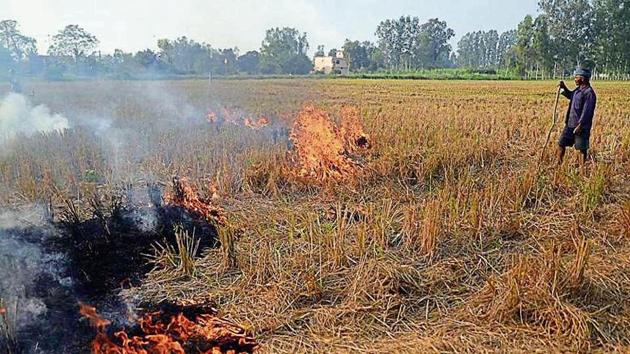EPCA writes to Punjab and Haryana to act against stubble burning
Delhi government data shows that in 2019, stubble burning accounted for 44% of air pollution in the national capital.
The Supreme Court-appointed Environment Pollution (Prevention and Control) Authority on Tuesday wrote to the chief secretaries of Punjab and Haryana, asking the states to control cases of crop stubble burning, after early instances began appearing in satellite imagery.

In his letter to the two primary stubble-burning states in the country, Epca chief Bhure Lal said crop residue burning had been spotted on satellite data recorded by System of Air Quality and Weather Forecasting and Research (Safar) and the United Nations’ National Aeronautics and Space Administration (Nasa).
He said it was imperative that early action be taken to control these fires ahead of the winters to control the annual pollution spike in Delhi.
Delhi government data shows that in 2019, stubble burning accounted for 44% of air pollution in the national capital.
Citing the Safar and Nasa data , Lal said 42 fires Monday, shown as ‘red dots’ on the map, were seen around various districts of Punjab, while 20 cases were observed on Sunday.
“EPCA has been monitoring progress with you on the implementation of the different measures in this past two months and has also worked out the clear benchmarks and targets that need to be achieved before the coming season. We would now request that these steps are taken with urgency,” Lal said in his letter.
The letter added, “We recognise that we have lost time because of Covid-19, but given that the winter season is now fast approaching, we need to tackle this with urgency and ensure compliance.”
The SC-appointed body also said that even though the impact of these early instances of burning is expected to be negligible on the air quality of Delhi at least in the next three days, because wind speeds are not currently supportive for transport and accumulation of smoke, the situation in Delhi will deteriorate in the coming weeks once the wind pattern changes.
Lal also asked state governments to set up control rooms ahead of the harvest season that will start functioning in full-swing from mid-October, to ensure that harvest machines are available easily to farmers and enforcement is prompt against violations.
Hindustan Times had reported on Tuesday that NASA had started observing early instances of crop residue burning is some districts of Punjab and Haryana. Recordings show that such instances had progressively been increasing from September 13, but had seen a spike over the last five days.
The worst affected district was Amritsar in Punjab, followed by Tarn Taran, Firozpur, and parts of Kapurthala, Mansa and Jalandhar.
Krunesh Garg, member secretary, Punjab Pollution Control Board, said the satellite imagery catches all kinds of fires, and said the images were not necessarily stubble burning.
“It is too early panic. Our teams are tracking any signs of early burning, but what we have largely observed is that compared to previous years farmers are more aware and are spreading the message of among their own neighbourhoods of not burning stubble,” he said.
Garg said monitoring teams will begin thorough monitoring from Wednesday to check for any violations.
In Haryana, where the only two or three instances were observed in parts of Fatehabad and Ambala, officials said the government has zero-tolerance for stubble burning this year.
“We have marked 38 villages that will be intensely monitored. Till now, we have not observed any instances of stubble burning on the ground. We are hoping that the cases will be less this year. We have see over the past few years that cases have progressively been reducing every year,” said S Narayanan, member secretary, Haryana Pollution Control Board.
In Punjab last year, 9.8 million tonnes out of 20 million tonnes of paddy crop residue was burnt. As many as 50, 738 cases of stubble burning was recorded by the state pollution control board in 2019. In Haryana, on the other hand 1.24 million tonnes out of 7 million tonnes of paddy crop residue was burnt.




